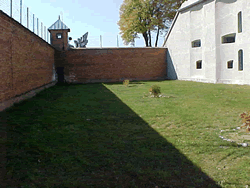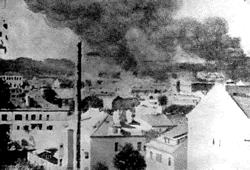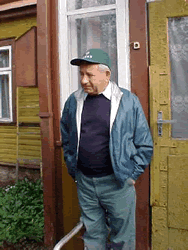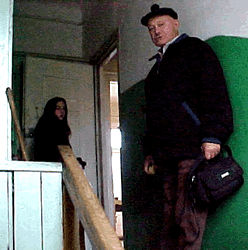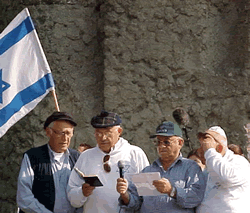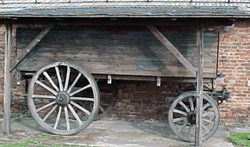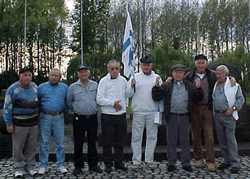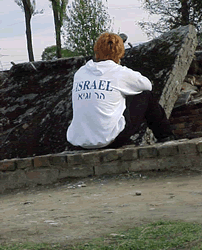The 131 Boys from Kovno
http://gfh.org.il/Eng/Index.asp?CategoryID=139&Page=1
When the Kovno ghetto was liquidated in July 1944, thousands of Jews were sent to the camps, among them children who had survived the "Children's Aktion" [roundup] in the ghetto. The women and children were taken off the train at the station in the vicinity of Stutthof concentration camp. This was a short and cruel parting from their mothers, brothers and sisters. With great sorrow, a number of boys decided not to get off the train. In fear and terror they and their fathers continued on to Landsberg camp.
The Beginning of the Journey – Kovno (Kaunas) Lithuania
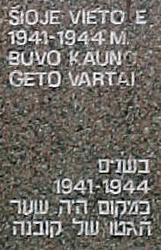
.....................
Stuthof Camp, Poland
Landsberg, Germany
Dachau, Germany
Birkenau, Poland
Mauthausen
.....................
Gunskirchen
.....................
The Molotov-Ribbentrop Pact was signed on August 23 1939, and it led to the entry of the Russians into Lithuania in the summer of 1940. The entry of the Russians into Lithuania caused the feeling of frustration in the Lithuanian people to intensify and greatly increased the cases of incitement against the Jews, with injury to their persons and damage to their property.
The German forces invaded Lithuania in 1941. Many of the Jews made desperate efforts to flee into the territory of the Soviet Union, but most of them did not reach their destination.
When the Germans entered Lithuania, the Lithuanians began to riot against the Jews. In Slobodka, a suburb of Kovno, approximately 800 men, women and children were cruelly slaughtered on the night of June 25. They also burned synagogues. All told, during the initial weeks of the occupation approximately 3,800 people were murdered in Kovno. These atrocious acts were carried out by the Lithuanians, headed by ultra-nationalists from among the intelligentsia, and by the Einsatzgruppen of the German Reich. From then on the murder of Jews entered a systematic planning stage of major dimensions, and in this case the main actors were also the Lithuanians themselves. Concurrent to the systematic slaughter, a ghetto was established in Kovno, and the Jews were ordered to wear yellow badges and to hand over all their valuables. After an ultimatum, the Jews were placed in the ghetto, which was finally locked on August 15, 1941. At that time there were 29,760 Jews. The Jews were forbidden to have any contact with the surrounding population. On October 28, 1941 the Germans carried out the "big Aktion" [roundup]: 10,000 Jews were taken out of the ghetto and sent to be exterminated.
The knowledge that the work of the Jews was a factor in postponing their liquidation motivated the Judenrat to take the utmost advantage of the manpower potential in the ghetto and to initiate work places within the area of the ghetto as well. There was a pause in the roundups in 1942, which led to recovery in the ghettos and the awakening of social and cultural life.
Tens of thousands of Jews from Kovno were murdered in the yard of the Ninth Fort
Towards the end of 1943, the Germans began to transfer Jews of working age to concentration camps, and the people who were considered unfit for work were liquidated. The ghetto became a concentration camp, and its area was reduced. When the front began to draw near to Lithuania in July 1944, the Germans began to evacuate the Jews who had survived in the ghetto and the labor camps and send them to Germany. There were a total of about 7,000 to 8,000 Jews in the ghetto and the surrounding labor camps. The deportations began on Saturday, July 8, 1944. Several thousand hid in the malinas (hiding places) that had been prepared for this moment. When the SS man G?cke saw that he was short a few thousand Jews, he sent Gestapo and SS units into the ghetto, including sappers, and they blew up house after house; that was the liquidation of the ghetto and it was carried out on August 1, 1944. The majority of Jews who had hidden in the hiding places were burnt or suffocated inside them. When Lithuania was liberated by the Red Army in the fall of 1944, only a few hundred Jews were to be found there. Only about 4 percent of the Jews of Lithuania survived the war.
Three weeks after the destruction of the Kovno ghetto, Kovno was liberated by the Red Army.
A picture of the Kovno ghetto on fire.Original: Ghetto Fighters' Museum
Out of the 40,000 Jews who had been in Kovno before the war, only about 3,000 remained. Two thousand five hundred were liberated in Germany and another 500 were partisans and in various hiding places with Lithuanians. The names of the Germans and Lithuanians who took part in the murder of the Jews of Kovno are in keeping at Yad Vashem. The names of the small number of Lithuanians, Poles and Russians who helped the Jews in any way during the atrocious war are also kept there.
Dani Labanovski returns to his house in Kovno during the journey. September 1999
Yaakov Viz returns to his childhood home. While we were there he coincidentally encountered an old neighbor, who gave him photos of members of his family who had been murdered
Stuthof Camp, Poland
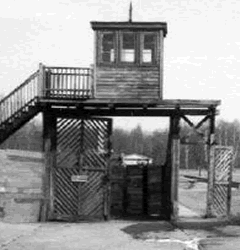
.....................
The Beginning of the Journey – Kovno (Kaunas) Lithuania
Landsberg, Germany
Dachau, Germany
Birkenau, Poland
Mauthausen
.....................
Gunskirchen
.....................
"There we parted from Mother"
Stutthof, Poland
The train halted beside the Baltic Sea, in a beautiful area near the city of Gdansk in Poland.
The women and children were taken off. They entered the camp. Some of them were immediately sent to their deaths, and some of them were sent to be exterminated in Birkenau several days later. Others were forced to work until they were murdered or died because of the harsh conditions. This was the place in which the boys from Kovno were separated from their mothers, sisters and little brothers. A hasty parting, which for the majority continued forever. From there the boys continued on with their fathers to Landsberg camp in Germany.
Kaddish for their mother – the children of the group from then – now fathers and grandfathers – reading Kaddish at the place where they last saw their mothers, brothers and sisters.
Photographed during a ceremony held by the group on the spot, against the background of the memorial monument in Stutthof, September 1999
Landsberg, Germany
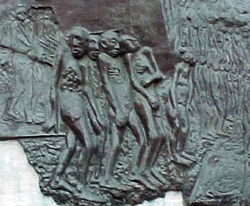
.....................
The Beginning of the Journey – Kovno (Kaunas) Lithuania
Stuthof Camp, Poland
Dachau, Germany
Birkenau, Poland
Mauthausen
.....................
Gunskirchen
.....................
"And our fathers remained behind"
Landsberg, Germany
Landsberg was a labor camp that was set up beside Dachau in 1944, for the underground airplane construction factory that was located there.
The group of 131 boys from Kovno arrived in Landsberg from Stutthof. The boys spent about a week in this camp. Afterwards they were separated from the adults and sent to Dachau. In the period of time between when the children were separated from the adults and removed from the camp, they were joined by one of the boys' older brother
Dachau, Germany
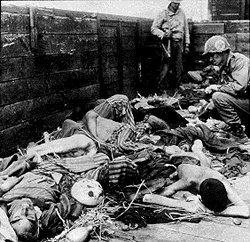
.....................
The Beginning of the Journey – Kovno (Kaunas) Lithuania
Stuthof Camp, Poland
Landsberg, Germany
Birkenau, Poland
Mauthausen
.....................
Gunskirchen
.....................
"We thanked the LORD that we were still alive"
Dachau, Germany
"In Dachau we were placed in one large, clean wooden hut. There were two-story bunk beds there. There were no clothes for us to change into there. Luckily for us it was summer, as we hadn't changed clothes since the Kovno ghetto. We were covered in lice, sores, etc.; in short, a sad and bad situation. We suddenly heard steps approaching. It was the Kapo, "the hut boss". He came and told us to undress completely and go shower. We thought our end had come. Many began to recite 'Shma Yisrael', and other didn't know what those words meant. We cried but we remained together as we walked to the unknown. The last moments of our short lives. We were sent into the showers, and wonder of wonders, water came out of them!
We laughed out loud and thanked the Lord that we were still alive. Another day had gone by. We spent seven days in the hut. On the seventh day the Kapo told us that we were going to travel to a 'children's village', where things would be better for us. There we would have lessons, eat well, in short, the End of Days! The little children of seven to ten were really excited, but the older ones were very worried. Our fear increased when our clothes were painted with highly noticeable red stripes – our shirts and pants. This was to make us easily identifiable if we fled, and where could we flee to?"
From Daniel Inbar's testimony
For the group of children from Kovno, Dachau was a stopover on the train trip from Landsberg to Birkenau. Throughout the entire trip to there the children consolidated into an orderly group. The children attribute this consolidation to Wolf Galperin, the older brother who volunteered to join his little brother when the children were taken out of Landsberg. From Dachau on everyone related to Galperin as the leader of the group.
The group of boys spent a week in Dachau – from the day they arrived from Landsberg until they were sent to Birkenau. For the 131 boys, Dachau was a station from which they left alive, but for tens of thousands this station was one of death. It was the oldest of the camps which was established in 1933 as a prison camp for opponents to the Nazi regime. The prisoners in the camp were forced to work for the Nazi war effort. Cruel medical experiments were carried out on thousands of prisoners, which led to their deaths. The methods of mass extermination were developed and tried out in this camp, which is only 15 kilometers from the huge German city of Munich
Birkenau, Poland
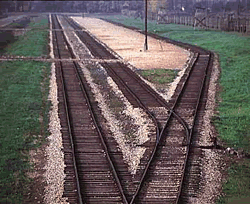
.....................
The Beginning of the Journey – Kovno (Kaunas) Lithuania
Stuthof Camp, Poland
Landsberg, Germany
Dachau, Germany
Mauthausen
.....................
Gunskirchen
.....................
The End of the Route
For hundreds of thousands of European Jews, the route ended here, life ended here. Hundreds of thousands arrived here and within minutes were sent to the gas chambers. For the majority of the boys in the group, this was also the end of the route. Only a few of the boys in the group, 39, had the luck to be liberated from here alive. The boys in the group arrived here on August 1, 1944, and for some reason that remains a mystery to this day, they were not immediately sent to the gas chambers. Consequently they were sent to have a number tattooed on their arms and then they were taken to Lager [camp] A, the transit camp at Birkenau. Two selections were carried out in September 1944, one on the eve of Rosh Hashanah and the second on Yom Kippur. Thirty-nine boys were left alive after the selections, and were sent to forced labor in Lager D, another section of Birkenau.
This is the entrance gate to Birkenau. For hundreds of thousands of people it was the gate of no return, the gate to death. The trains entered one after another, filled with men, women and children, and departed empty. Their human cargo was murdered here, in the largest killing field humankind has ever known.
The living conditions were impossible. Eight or more children slept on each of these bunks (on each tier). Crowding. Disease. Hunger. "The smallest injury was a death sentence because the lack of food prevented it from healing," one of the boys related. Death was a constant shadow. Every night there was a roll call in which the children were sorted – who would live and who would die. The "sentence" was always only carried out the next day. Immediately after the roll call, all the boys were sent back to the barracks, those sentenced to life and those sentenced to death. "You were sleeping in a bed with people who were already dead," they testified. The group spent the longest period of time in Birkenau, until close to the time that the camp was liberated. Then, on January 18, 1945 the Death March began.
The Roll-Wagen, the transport cart. The children of the group were put to work dragging this cart. Eight boys dragged the cart, which among other things moved corpses.
A group photo: eight of the survivors from the group who took part in the journey in 1999, against the background of the monument in Birkenau, on the ruins of the crematoria, which were the end of the road for most of their comrades. From right to left: Moshe Kravetz, Dani Hanoch, Moshe Shoham, Dani Labanovski, Meir Gecht, Yaakov Viz, Zundel Gordon.
"…and you sit there, across from the inferno,
look it right in the eye, and have trouble believing it.
Find it hard to grasp the Ninth Fort, Ponary
Stutthof, Treblinka and Birkenau.
You sit with what is considered
the greatest atrocity created by humankind,
and see the greenery, the sunset,
bite your lip, look at your friends,
some crying, and still find it hard.
Your heart finds it hard to grasp
what your mind has long since understood."…
(From the diary of one of the students)
One of the members of the delegation from Har Vagai School sitting beside the ruins of the crematoria. September 1999
Mauthausen
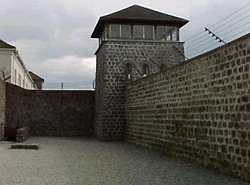
.....................
The Beginning of the Journey – Kovno (Kaunas) Lithuania
Stuthof Camp, Poland
Landsberg, Germany
Dachau, Germany
Birkenau, Poland
.....................
Gunskirchen
.....................
Mauthausen was a prison that was transformed into a concentration camp after the annexation of Austria to Germany.
Thirty-seven of the boys in the group arrived here near the end of January 1945. In contrast to the other camp inmates, the children of the group were not put to work. During their time there they were transferred to several places within the camp. They remained there until the middle of April 1945; at that time they were taken on another march to Gunskirchen.
The camp inmates were forced to work at transporting what was quarried in the nearby valley to the camp itself. The ascent from the valley is constructed of thousands of steps. Thousands of people were killed falling off the steps, when the SS soldiers pushed them down into the abyss.
The entrance to the steps of death, as they looked then
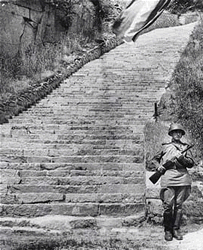
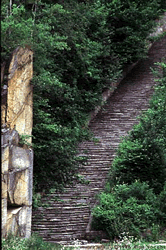
---------------------------------
First of all, let me say something personal…
It isn't easy to turn a human story into a website that is open to all. It is even less easy to do so when referring to a group of 23 members, who differ from each other in how they remember the events and in the story they relate. The distance of time does not always sharpen memory, and in the final analysis the editors of the website have to decide what will be placed on the website and to what degree. Many decisions are made while working on the website, and arguments can be made for and against every one of them.
Each time that we searched for pictures for the new website in the archives, we were forced to contend with the dilemma of whether to insert the pictures of atrocities (as the entire archive is full of such pictures). After lengthy deliberations we decided not to place such pictures on the website, not because they have no connection to the subject, but because we feel that we are bringing a kind of story of childhood to the site, children whom the circumstances forced to cope with the atrocities. We hope that this story will also be read by children, and we don't want to confront them with pictures of atrocities. In addition, our experience has taught us that such pictures tend to overshadow the story for the viewer, and it is the story that we want to tell.
An additional dilemma we faced was how much historical information to include. After lengthy discussions we decided to limit it in order not to distance the story from the viewer. We always tried to find a way to provide the reader with the information required to understand the story and the circumstances leading to its occurrence, but nevertheless not to cause the story to become lost. Factual information can be found in any history book and on every website, but the story of the group can't be found elsewhere.
Despite the difficulty, we tried to touch on and relate, not to teach or preach. We have attempted to tell you one story, one out of the many that this terrible period has supplied us.
What did the Website Grow Out Of?
In 1998 Moshe Kravetz began to search for a framework for passing on his story and the story of the 131 boys from Kovno (of whom he is one) to the future generations. During his search he told his unusual story to the staff of Yad LaYeled museum at the Ghetto Fighters' Museum, and to the students and teachers of Har Vagai School. These three factors, Moshe Kravetz, Yad LaYeled and Har Vagai School, joined forces and began to start the wheel turning. The process was a long one, and during it the students interviewed the survivors from the group and began to document all possible material. Tome-like papers were written about the group of 131 boys from Kovno. Conversations began to progress. In September 1999 the student, accompanied by eight members of the Kovno group, even went on a journey and retraced the route the group had taken during World War II. The journey reopened stories that had not yet been heard and released the emotions of those who had buried them for fifty years. These emotions that were let out of the bottle enveloped everyone, both survivors and students. Memories were dredged up and related. During the journey we were already in the middle of constructing the website, but in the wake of the journey it was completely altered – from an almost historical website, to a website of narrative and emotions, to the extent that this is possible.
We would like to thank the following people and bodies:
à All the children of that time, the witnesses of today, who revealed their story and opened their hearts and emotions to us; who took us with them to the realm of their childhood and made us vow, albeit unconsciously, to continue telling the story.
à All the students who worked day and night, and many more nights, in order to find all possible information, every document, every fragment of a story, and took it all and created a wealth of written, photographed and filmed documentation – and this website. They have also revealed their emotions to us.
à The staff of Yad LaYeled, among them Shlomit Dagan-Deri and Tali Shner, who provided mentoring, backing and support, and helped tie all the threads together.
à The staff of Har Vagai School, among them Sophie Ben-Artzi, who took on the project with great emotion, while providing support, help and a shoulder to this entire commemoration project, and Riva Meno, who provided invaluable support and help.
à Pini Yaron, who documented the entire project and journey on video. For the product of all this here, on the page explaining the film "When Children Remember".
à All the people who lent a hand in any way – and the server is too small to contain. We would all be pleased to receive your responses, comments, stories and questions.
"Their memory will be a sign and testimony for us for all eternity."
Israel, 2001
IN MEMIORIAN
![]()
And these are the names of those who did not live to see the liberation
Alperowitz Avraham
Born March 31, 1931
Astajek Yaakov
Astrodomov Y. L.
Atlas Ami
Born July 5, 1932
Berman David
Born May 28, 1930
Birman Efraim
Born March 1, 1929
Bloch Yitzhak
Blumberg Yoel
Born May 1, 1930
Braun Yitzhak
Born November 29, 1931
Burek Yosef
Born February 17, 1928
Chait Feliks
Disler Yakel
Born August 13, 1930
Eidelman Yaakov
Born July 16, 1930
Feivuš Abba
Fiš Hirsh
Fort Zalman
Born March 13, 1930
Fridenberg Menachem
Born July 12, 1931
Fridman Pavel
Fridman Yaakov
Born June 14, 1932
Gavronski Naftali
Gempel Bezalel
Born July 25, 1930
Gempel Shimon
Born January 15, 1930
Gerber Motel
Born March 8, 1930
Gerson Yehoshua
Born January 10, 1930
Geselson Kushel
Born July 9, 1932
Gilinski Melech
Born April 13, 1930
Goldšmit Leib
Born May 8, 1930
Golub Avraham
Born December 2, 1930
Greišpul Marius
Born September 8, 1929
Grinstein Hune
Born May 5, 1931
Gutner Wolf
Gu?anski Gershon
Born November 14, 1930
Hof Shlomo
Born January 22, 1930
Janovitz Meir
Born December 28, 1932
Kagan Moshe
Born September 16, 1930
Kagan Reuven (Henrik)
Born November 5, 1931
Kamber Moshe
Born December 1, 1930
Kamen?ik Nahme
Kanovitz Haim
Born June 6, 1928
Kaplan Shlomo
Born March 12, 1931
Karokin Leib
Born May 1, 1930
Katz David
Born December 4, 1931
Kaufman Eliezer
Klikovitz Shimon
Born February 26, 1930
Kobel Yosef
Born June 15, 1928
Kopelman Shmuel
Born December 16, 1936
Kopelov Hune
Krasienišok Leib
Born July 2, 1934
Kremer Aharon
Kubilkovski Yaakov
Kurtzer Yosef
Born November 29, 1929
Lanzman Haim
Born June 10, 1930
Lekert David
Born May 21, 1928
Lipkovitz Yitzhak
Born December 10, 1930
Luria Heinrich
Born February 17, 1931
Luria Leo
Born April 27, 1929
Marijaš Yisrael
Born September 15, 1932
Marshak Motel
Mašianski Daniel
Born September 15, 1929
Mator Yisrael
Born July 17, 1931
Melnik Leib
Melnik Pesach
Milner Shmuel
Ozoras Abba
Born February 13, 1930
Paimau Moshe
Born July 18, 1930
Pavrovski Elia
Born July 23, 1930
Prova Nahum
Reznicki Shmerl
Rochelson Boris
Born October 9, 1930
Rozenblat Meir
Born March 24, 1932
Rozenblum Ivsai
Born July 7, 1929
Sanovski Yosef
Born February 2, 1931
Schuster Yitzhak
Schwartz Reuven
Born January 3, 1930
Schwartz Shmuel
Born January 19, 1932
Shapira Moshe
Shoham Yaakov
Born September 29, 1929
Škliar Yaakov
Sneider Yehoshua
Born September 9, 1929
Spitz Haim
Born September 26, 1930
Steinbek Michael
Born December 28, 1932
Šverin Yaakov
Tarshish Haim
Born April 1, 1929
Valet Zosia
Zeidel Lapid
Born February 11, 1932
Zitel Leib
Born January 16, 1929
